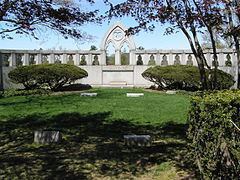Name William Duzer | ||
 | ||
Died 1927, Bronxville, New York, United States | ||
William Van Duzer Lawrence (1842–1927) was a millionaire real-estate and pharmaceutical mogul who is best known for having founded Sarah Lawrence College in 1926. He played a critical role in the development of the community of Bronxville, New York, an affluent suburb of New York City defined by magnificent homes and charming garden apartments in a country-like setting. His name is attached to Lawrence Hospital, the Lawrence Park Historic District and real estate brokerage Houlihan Lawrence.. Lawrence is buried at the Kensico Cemetery in Valhalla, New York.
Contents
Development of Bronxville, New York
Lawrence used his wealth to pursue a wide variety of entrepreneurial and philanthropic enthusiasms. One of these was the development of real estate. In 1889, at the suggestion of his brother-in-law, he came out on the New York and Harlem Railroad to the small village of Bronxville to examine the prospects of a former farm of approximately 86 acres (350,000 m2) near the railroad station. He appreciated the possibilities of the property and its convenient location and purchased the entire property the following year. He envisioned a planned community of well-designed and well-built suburban homes. The lots were relatively modest in size and irregular in shape. They were not intended to be estates for the rich but sites large enough for comfortable middle-class homes, each planned to take advantage of the natural setting. The narrow, meandering roads were laid out to follow the contours of the land, and existing trees were preserved whenever possible.
He hired an architect by the name of William Augustus Bates to design the first houses of the development, to be called 'Lawrence Park'. Bates had a versatile style which borrowed freely from the many different styles in fashion at the turn of the 20th century. He favored certain features such as large bays with multiple windows and round or octagonal towers with conical roofs. The first houses sold quickly and Bates went on to design most houses in the neighborhood. The development soon proved to be a success, and within a couple of decades most of the original property was developed and Lawrence bought more land to extend its boundaries. The newer sections were designed primarily in the Tudor Revival or Colonial Revival style; however, Bates' nineteenth-century blends of Romantic forms remain the most admired. The Lawrence Park Historic District was added to the National Register of Historic Places in 1980. Lawrence's business plan was designed to attract a friendly, homogenous population of upper-middle-class residents - professionals, business managers, and the like. The development proved particularly attractive to established artists who were successful commercial painters, illustrators, and sculptors. It soon became a community within a community, very close-knit and proud of its special qualities. It was never intended to be socially or economically diverse. Even its complex of townhomes, Merestone Terrace, was designed and constructed to much higher standards than ordinary multi-family housing in order to attract more affluent clients. Limiting most construction to one-family homes on large lots helped to discourage people of limited financial means from settling there. It was hoped that these measures, combined with restrictive covenants or "gentleman's agreements," would maintain the white, Protestant, affluent, suburban character for decades. There was nothing subtle or hidden about this agenda. Lawrence Park proudly advertised in House and Garden in 1925: "Restrictions? Yes! Bronxville has been carefully guarded in its development.... The index of desirability has always been character, culture, and the ability to fit easily and naturally into the social scheme."
Contributions
William Van Duzer Lawrence left behind several significant institutions including Sarah Lawrence College and Lawrence Hospital. One of his legacies was directly connected to Lawrence Park: Houlihan Lawrence, one of the nation's largest real estate firms, is a direct descendant of Lawrence Park Realty Company.
Lawrence embodied ideas from the Progressivist movement of the 1890s, especially his view that the arts were a crucial element in the social evolution of individuals and families, in developing both private and public sensibilities, and in creating equal relations between men and women.
Family
William and Sarah Lawrence had five children: Alice (1868-1869), Louise Lawrence Meigs (1870-1965), Arthur W. Lawrence (1875-1937), Anna Lawrence Bisland (1873-1950), and Dudley B. Lawrence (1880-1970). Anna and her husband, Pressley Bisland, were the foster parents of poet Lawrence Ferlinghetti (née Ferling), who had been left at their Plashbourne Estate by his maternal aunt—the Bisland's French governess. The Lawrence children and grandchildren continued to run their father's real estate business until 1990, when it was acquired by another local family.
The Lawrence family boasts an impressive ancestry said to descend from Sir Robert Lawrence of Ashton Hall, Lancashire, England, who accompanied Richard Coeur de Lion in the Third Crusade. John Lawrence, who arrived at Plymouth, Massachusetts in 1635, was a patentee of Hempstead, New York under Dutch governor WIlliam Kieft and served as a three-term mayor of New York City. William Lawrence (1620-82), along with John, held additional patents and settled a large portion of present-day Flushing and Bayside in Queens. Another notable ancestor was War of 1812 martyr Captain James Lawrence, whose dying wish, "Don't give up the ship," is immortalized in American history.
